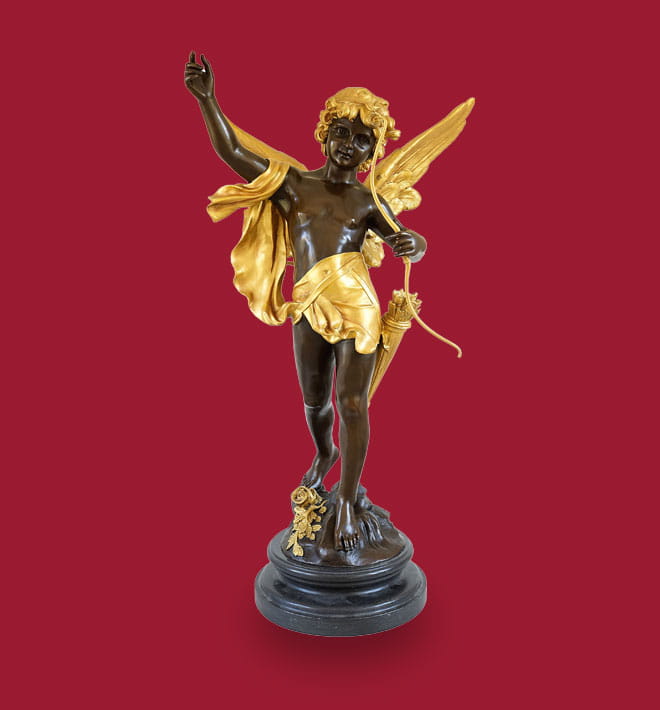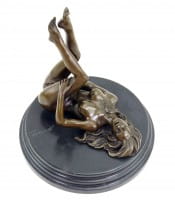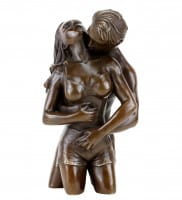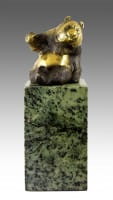€389.00 *
Prices incl. VAT, free shipping worldwide
Ready to ship today,
Delivery time appr. 3-6 workdays










The Messenger of the Gods – Hermes - Signed Giambologna The Statue of Hermes by Giambologna... more
Product description
"Statue of Hermes - Giambologna - Greek Mythology"
| Weight | 2,4 kg |
The Messenger of the Gods – Hermes - Signed Giambologna
The Statue of Hermes by Giambologna is one of the most elegant representations of classical mythology ever cast in bronze. This masterpiece captures the very essence of movement — the fleeting instant when the god, poised on the tip of his foot, is about to ascend toward the heavens. His slender body stretches upward in perfect balance, his right arm raised in divine gesture, and his gaze fixed on the celestial realm. The Hermes Statue Greece embodies grace and dynamism, expressing both the weightlessness of air and the spiritual freedom of the Olympian messenger. The polished bronze surface reflects light like living flesh, granting this sculpture an almost divine presence that transcends material form.
The Genius of Giambologna
Giovanni da Bologna, known as Giambologna, was born 1529 in Douai in northern France and later became one of the most celebrated sculptors of the Italian Renaissance. His early education in Antwerp exposed him to the refined craftsmanship of Flemish sculpture, while his later studies in Rome immersed him in the legacy of Michelangelo and classical antiquity. Giambologna’s artistic language blended the anatomical precision of his northern roots with the idealized beauty of Italian form. His Statue of Hermes reflects this synthesis: it is both technically perfect and emotionally alive. Working in Florence under the patronage of the Medici family, he established a workshop that produced some of the most graceful bronzes of the period, among them the radiant Messenger of the Gods Mercury.
The Symbolism of Flight
In this composition, Hermes — or Mercury, as he was known to the Romans — is portrayed at the very instant of takeoff, balancing lightly upon a breath of air symbolized by the head of Zephyr, the god of wind. The upward thrust of the figure, his outstretched arm, and the twisting torso together create an unbroken flow of energy. Giambologna mastered the contrapposto, infusing the sculpture with rhythm and vitality. The Hermes Statue Greece is not merely a depiction of the divine messenger; it is an allegory of transcendence and the eternal human longing for movement beyond the earth. Every curve of the body seems to respond to invisible currents of divine speed and spiritual purpose.
The Perfection of Bronze
Giambologna’s technical expertise in bronze casting allowed him to achieve levels of refinement previously unseen in Renaissance sculpture. The Statue of Hermes gleams with subtle tonal variations that enhance its sensuality and realism. The surface transitions fluidly between polished and matte textures, emphasizing the musculature and anatomical tension of the god’s body. The light catches on Hermes’ helmet and caduceus, drawing attention to his dual nature as both protector and communicator. Each element, from the delicate wings on his sandals to the serene expression on his face, reflects the sculptor’s profound understanding of harmony. The Messenger of the Gods Mercury thus becomes a study in the relationship between material and divine motion.
A Legacy in Bronze and Spirit
The Hermes Statue Greece is today admired in renowned collections such as the Uffizi Gallery in Florence and the Bargello Museum, where several original casts and later reproductions stand as testimony to Giambologna’s enduring mastery. Copies of this model spread throughout Europe, inspiring generations of artists to explore the balance between beauty and movement. Collectors continue to value the Statue of Hermes for its timeless elegance and mythological depth, recognizing it as a symbol of communication between gods and mortals. The sculpture’s upward-reaching gesture continues to captivate, inviting the viewer to share in the divine journey of thought and form.
The Life of a Renaissance Visionary
Giambologna’s life in Florence was marked by discipline, devotion, and refinement. Though born in France, he became deeply rooted in the intellectual world of Italy, surrounded by architects, painters, and philosophers who shared his pursuit of perfection. His patronage under the Medici gave him access to the finest materials and the most ambitious commissions, from mythological bronzes to monumental fountains. He remained unmarried, dedicating his life entirely to his craft and to the pursuit of aesthetic harmony. His Messenger of the Gods Mercury stands as his ultimate expression of that vision — a sculpture that unites grace, intellect, and divine inspiration in one eternal gesture of flight.
A Gesture Toward the Infinite
The Statue of Hermes endures as one of the most poetic images of ascension in Western sculpture. Through Giambologna’s mastery of form and movement, the bronze figure defies gravity, capturing the moment when mortal craftsmanship touches the divine. In its gleaming surface and flowing contours lies the sculptor’s lifelong meditation on beauty and perfection. The Hermes Statue Greece remains not merely a figure of mythology but a timeless embodiment of aspiration, elegance, and motion made eternal.
The Statue of Hermes by Giambologna is one of the most elegant representations of classical mythology ever cast in bronze. This masterpiece captures the very essence of movement — the fleeting instant when the god, poised on the tip of his foot, is about to ascend toward the heavens. His slender body stretches upward in perfect balance, his right arm raised in divine gesture, and his gaze fixed on the celestial realm. The Hermes Statue Greece embodies grace and dynamism, expressing both the weightlessness of air and the spiritual freedom of the Olympian messenger. The polished bronze surface reflects light like living flesh, granting this sculpture an almost divine presence that transcends material form.
The Genius of Giambologna
Giovanni da Bologna, known as Giambologna, was born 1529 in Douai in northern France and later became one of the most celebrated sculptors of the Italian Renaissance. His early education in Antwerp exposed him to the refined craftsmanship of Flemish sculpture, while his later studies in Rome immersed him in the legacy of Michelangelo and classical antiquity. Giambologna’s artistic language blended the anatomical precision of his northern roots with the idealized beauty of Italian form. His Statue of Hermes reflects this synthesis: it is both technically perfect and emotionally alive. Working in Florence under the patronage of the Medici family, he established a workshop that produced some of the most graceful bronzes of the period, among them the radiant Messenger of the Gods Mercury.
The Symbolism of Flight
In this composition, Hermes — or Mercury, as he was known to the Romans — is portrayed at the very instant of takeoff, balancing lightly upon a breath of air symbolized by the head of Zephyr, the god of wind. The upward thrust of the figure, his outstretched arm, and the twisting torso together create an unbroken flow of energy. Giambologna mastered the contrapposto, infusing the sculpture with rhythm and vitality. The Hermes Statue Greece is not merely a depiction of the divine messenger; it is an allegory of transcendence and the eternal human longing for movement beyond the earth. Every curve of the body seems to respond to invisible currents of divine speed and spiritual purpose.
The Perfection of Bronze
Giambologna’s technical expertise in bronze casting allowed him to achieve levels of refinement previously unseen in Renaissance sculpture. The Statue of Hermes gleams with subtle tonal variations that enhance its sensuality and realism. The surface transitions fluidly between polished and matte textures, emphasizing the musculature and anatomical tension of the god’s body. The light catches on Hermes’ helmet and caduceus, drawing attention to his dual nature as both protector and communicator. Each element, from the delicate wings on his sandals to the serene expression on his face, reflects the sculptor’s profound understanding of harmony. The Messenger of the Gods Mercury thus becomes a study in the relationship between material and divine motion.
A Legacy in Bronze and Spirit
The Hermes Statue Greece is today admired in renowned collections such as the Uffizi Gallery in Florence and the Bargello Museum, where several original casts and later reproductions stand as testimony to Giambologna’s enduring mastery. Copies of this model spread throughout Europe, inspiring generations of artists to explore the balance between beauty and movement. Collectors continue to value the Statue of Hermes for its timeless elegance and mythological depth, recognizing it as a symbol of communication between gods and mortals. The sculpture’s upward-reaching gesture continues to captivate, inviting the viewer to share in the divine journey of thought and form.
The Life of a Renaissance Visionary
Giambologna’s life in Florence was marked by discipline, devotion, and refinement. Though born in France, he became deeply rooted in the intellectual world of Italy, surrounded by architects, painters, and philosophers who shared his pursuit of perfection. His patronage under the Medici gave him access to the finest materials and the most ambitious commissions, from mythological bronzes to monumental fountains. He remained unmarried, dedicating his life entirely to his craft and to the pursuit of aesthetic harmony. His Messenger of the Gods Mercury stands as his ultimate expression of that vision — a sculpture that unites grace, intellect, and divine inspiration in one eternal gesture of flight.
A Gesture Toward the Infinite
The Statue of Hermes endures as one of the most poetic images of ascension in Western sculpture. Through Giambologna’s mastery of form and movement, the bronze figure defies gravity, capturing the moment when mortal craftsmanship touches the divine. In its gleaming surface and flowing contours lies the sculptor’s lifelong meditation on beauty and perfection. The Hermes Statue Greece remains not merely a figure of mythology but a timeless embodiment of aspiration, elegance, and motion made eternal.
Width: 15,5 cm
Height: 43 cm
Depth: 12 cm
Weight: 2,4 kg
100% Bronze
Related links to "Statue of Hermes - Giambologna - Greek Mythology"
Read, write and discuss reviews... more
Customer evaluation for "Statue of Hermes - Giambologna - Greek Mythology"
Write an evaluation
Evaluations will be activated after verification.
Our advantages
free shipping
Worldwide free shipping
14 days money back
You can cancel your order
within 14 days
secure payment services
Paypal, Master Card, Visa, American Express and more
NEW
NEW





















































